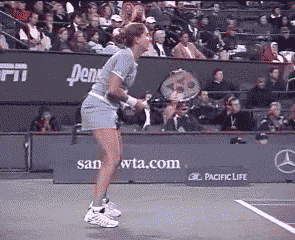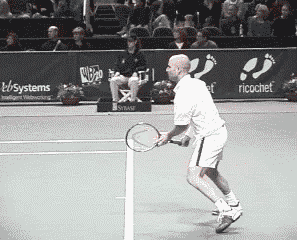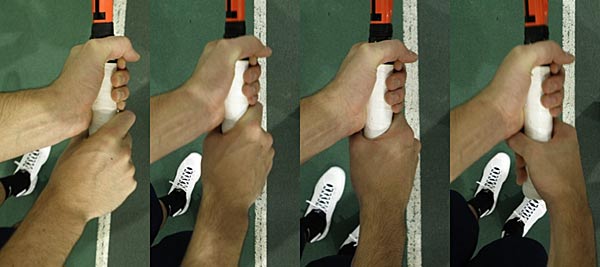|
TennisOne Lessons Two-Handed Backhand Styles Part 1 Doug Eng EdD, PhD If you're like the rest of us, you've probably heard plenty of advice like this for the backhand.
But these kinds of backhand tips won’t work for every player. Rather they refer to contrary techniques. Some backhands are like off-handed (i.e., left hand for a right-handed player) forehands. And some backhands are like one-handed backhands with extra support. Tennis great Chris Evert said that as a child she adopted the two-hander since she could not support the heavy wooden racquet with one hand. Monica Seles and Jim Courier relied significantly on their off hands. Andre Agassi, like Evert, relied on the dominant hand (i.e., the right hand for right-handed players) to swing. Young children gravitate to the two-hander since the second hand provides excellent racquet head stability, and hence, greater consistency. It also forces them to rotate their bodies, thereby using angular momentum more effectively. You might have been taught to play either backhand technique but struggle to identify how you want to use the hands. Many of the problems evolving from the two-hander are due to confusion on mechanics. That is, sometimes we use inappropriate mechanics for a particular two-handed technique. There are specific mechanics associated with the different techniques. In addition, different techniques lead to different tactics.
The technique of the two-handed backhand could be classified according to:
Let's investigate the salient checkpoints to understand why a wrist might break or elbows bend for a particular backhand technique. In Part 1, we will examine the use of different grips and their effect on wrist, hand dominance and elbow positions. In Part 2, we will look at the backswing styles and some tactical shots based on backhand styles. We will also peek at what might be the future trend for the two-handed backhand. The Grip, Wrist, and Hand Dominance The foundation of the basic technique lies with the dominant hand grip. Understand this and you can understand your own two-handed backhand better. The grip determines which hand will primarily control the swing. In Figure 1, we see grip variations for a right-handed player.
If your dominant hand is in the eastern backhand grip, that (dominant) hand will control the swing. If your dominant hand is in the continental grip, either hand can control the swing. More problematic and unadvisable is using the dominant hand to control the swing while using an eastern forehand grip. Essentially, the more the dominant hand moves to a forehand grip, the more likely the off hand will control the swing. The more the dominant hand moves to a backhand grip, the more likely the non-dominant hand will control the swing. Why? Consider the position of the dominant hand and the wrist at the contact point. If the dominant hand is in the backhand grip, the wrist is behind the racquet head as in the far left of Figure 1. In that position, the "thenar eminence" is directly behind the racquet handle. The thenar eminence is just the scientific name for the fleshy palm muscle between the thumb and the wrist. This palm part and the thumb provide good support. In addition, the wrist is behind the racquet at contact. With this grip, the dominant hand primarily controls the racquet.
If the right hand is in an eastern forehand grip as in the right photo of Figure 1, the thenar eminence does not provide support. Rather your fingers are behind the racquet handle and provide marginal support at contact. In addition, the wrist is in front of the racquet rather than behind the racquet. That forces the wrist to flex or bend into a weak position. So with an eastern forehand grip, we see marginal support by the fingers and some wristiness. With this grip, the off-hand therefore provides strength and primarily controls the racquet. This grip is generally not recommended. Most top players use a continental grip with the dominant hand. With a continental grip, either hand may control the racquet head. In addition, some good players use an Australian forehand grip (third from left - Figure 1, aka a modified continental grip) which is between a continental and an eastern forehand grip. It allows some support by the dominant hand and allows more wrist movement than the continental grip. In addition, if your racquet grip is small for your hands, you can get more palm around the racquet. A large racquet grip reduces palm support. Using a continental allows you to slice, drop shot, or volley effectively with one hand without changing grips. The Australian forehand grip on your dominant hand creates a more open racquet face on a one-hander offering extra slice. You may find it excellent for the drop shot. With the continental or Australian forehand grip, it is sometimes difficult to determine which hand dominates. The best way to determine which hand is dominant is by watching the amount of wrist flexion in the backswing. A key position in examining use of the wrist is in the down phase of the backswing. In Figure 2, we see some top juniors from the 2008 ITF Orange Bowl in Miami. Note all have some dominant wrist flexion. So to some degree they are relying on the off-hand. Relatively straight arms are shown by the Domijan, Yang and McHale.
Elbow Position We found that the grip effects the hand and wrist positions. In turn, the elbow position and swing size are also effected by the grip. Some top coaches suggest there are gender differences in the elbow position. Try this: place both hands on the racquet using the continental grip. Both wrists will be on top of the racquet as shown in the left photo of Figure 3. Notice your elbows will be fairly straight and close together. Now try using eastern forehand grips for both hands. The hands will be on opposite bevels (i.e., the flat edges of the racquet handle) and your thumbs will be on top and together. Note that your elbows stick out as if they were bow-legged. Thus, you see how your grip generally effects the elbow positions.
No touring pro actually uses these extreme grips. So explore and move your hands around the racquet handle into different grips and you’ll notice some positions move the wrists apart and some move them together. The grips that move the wrists farther apart will also move the elbow farther apart. Looking at elbow positions is a great way of classifying backhands. You can spot the elbows on a player from a distance far away. If you observe wrists and grips, you need to be a bit closer. In addition, elbow position is related to the size of the swing. You can get a wider swing radius by straightening the elbows. Whichever grip you take, if you bring the racquet and hands closer to your belly button, your elbows will naturally bend. That gives you a shorter swing radius. It might make sense that a wider swing might get more power since it could potentially get more racquet head speed. So why would anyone want a shorter swing radius or a swing closer to the body? A more compact swing close to the body allows the hips and core to support the swing better at contact. Reaching away from the body offers less stability and balance. Some top coaches have noted that women tend to use the elbows more bent and closer to the body. Men tend to swing farther away from the body. Why? Female touring pros generally have smaller shoulders than male touring pros so a female’s arms hang down naturally closer to the hips. The width of the male shoulders naturally produces a swing father away from the hips. In addition, a female pro’s upper body usually isn’t as strong so she may try to generate more racquet head speed by using her powerful lower body including the hips and legs. Proportionally by mass, a woman’s lower body is as strong as a man’s. By placing the hands and elbows closer to the body, she can benefit from angular momentum generated by the hips and core. Furthermore, a woman’s waist tends to be smaller than a man’s, so she can easily get her elbows closer into her body providing more stability at contact. Last, the elbows will tend to bend more as they get closer to the body.
Figure 4 shows three up-and-coming juniors from the recent ITF Orange Bowl in December 2008. Christina McHale has played in the recent Australian Open and Asia Muhammad has made a splash on the lower rungs of the WTA circuit. Note the use of the elbows against the body for extra support and strength. Only 13 years old, Madison Keys on the far right is an outstanding example of how to use the lower body to generate pace. I think you may hear a good deal of her in three or four years. At contact, we can also assess which arm controls the swing by looking at the elbow positions. In Figure 5, we again see some of our top juniors. Interestingly, on the far right, Asia Muhammad’s elbows are significantly bent. Her hands are the closest to her body as she appears slightly jammed. In addition, the contact point is rather high so to lift her racquet, she bends her elbows. In the middle two photos, Yang and McHale both have straight off arms which almost resemble the contact point on a forehand drive. Also note the two girls are off the back foot since they have moved backwards deep in the court to hit a high ball. That extra upwards movement off the back foot helps add some height to return the ball deep.
Finally comparing Figures 2 and 5, we can see that the dominant arm goes from a straight to a bent position from the bottom of the backswing to the contact point. Try hitting a forehand with your off hand (without using your dominant hand). You will find the elbow will bend on the backswing and straighten out on contact. This action is significant as the off hand will provide extra acceleration and move ahead of the dominant hand as we will discuss next time. In Part 2, we will look at the use of the arms at contact, backswing styles, and tactics. Your comments are welcome. Let us know what you think about Doug Eng's article by emailing us here at TennisOne.
Doug Eng EdD PhD coaches men's tennis at Tufts University. During the summer, he directs at the Tennis Camps at Harvard. He has received divisional Pro of the Year honors from the PTR and USPTA and several national award. Doug completed the USTA High Performance Coaches program and frequently runs educational and training programs for coaches. Doug also writes and speaks on tennis and sport science. |








